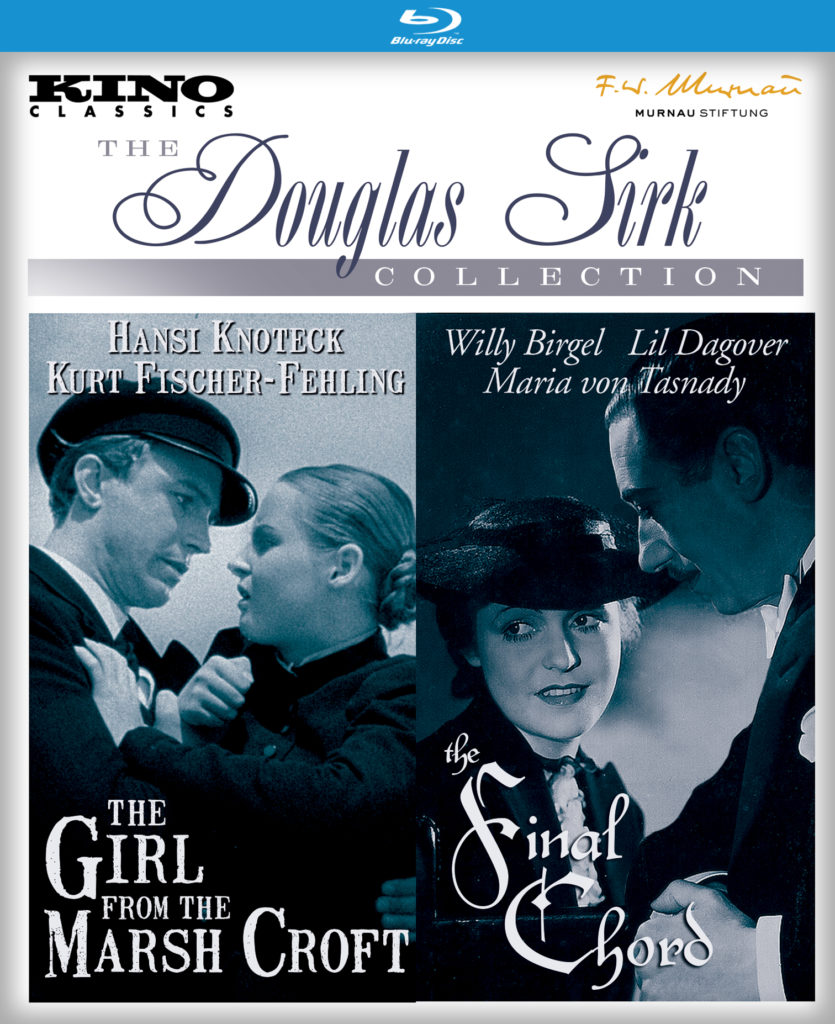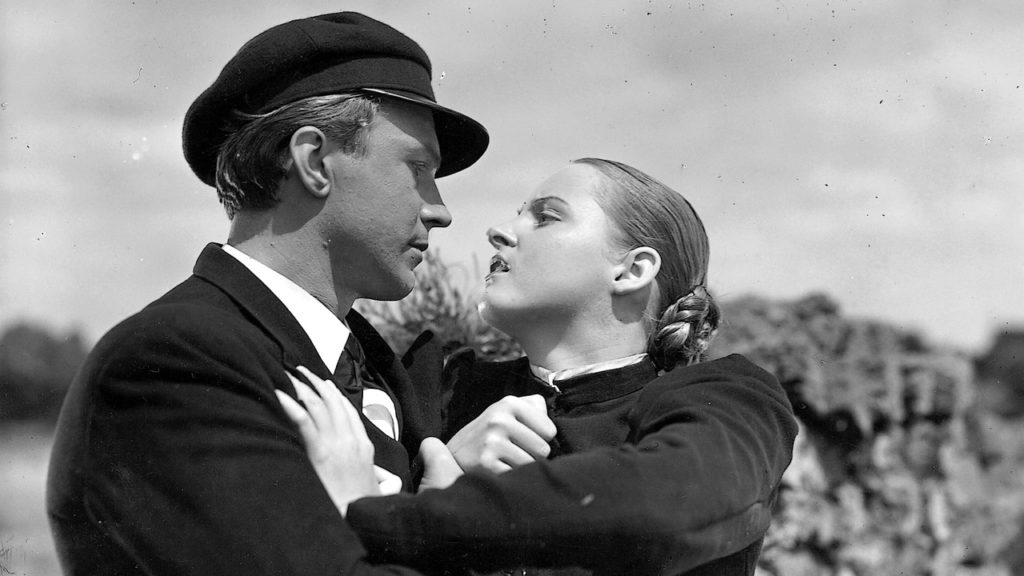Customs Of The Country
DIRECTED BY DETLEF SIERCK (DOUGLAS SIRK)/GERMANY/1935 & 1936
STREET DATE: FEBRUARY 22ND, 2022/KINO CLASSICS

Kino Classics releases two prewar German films directed by the future Douglas Sirk on a single-disc Blu-ray set this late February.
Detlef Sierck was a young Berlin stage-director who transitioned to film in the mid-1930s when offered a contract for directing a series of film shorts at the powerful Universum-Film AG, better known as UFA. At that particularly fraught period of German history, the film studio had been recently depleted, one might say purged, of key artistic personnel by its ultra-rightwing financiers who, representing and enacting the interests of the Nazi government, would soon transition to nationalized film production; thus making UFA a weaponized media and informational instrument of the Nazi regime, its Ministry of Propaganda, and Propaganda Minister Joseph Goebbels himself. UFA during this destabilized period had an obvious, pressing need to cultivate new, “acceptable” talent, and the young Hamburg-born, Danish-ancestry Sierck quickly rose to prominence with his third solo feature film, the accomplished classical music melodrama The Final Chord (or Final Accord; German title Schluβakkord [1936]), which was specifically (and significantly) chosen to premiere shortly before the fateful Berlin Summer Olympics of 1936.
Seven years later, Detlef Sierck would become Douglas Sirk, and his first Hollywood film, directed under his new Americanized name, would be the low-budget although unmistakably titled Hitler’s Madman (1943). Slowly rising through the studio ranks of the late 1940s and early ‘50s with a variety of striking if boilerplate B-pictures – encompassing romances, thrillers, light comedies, even Westerns – Sirk returned to the artistic milieu of his very first screen success with a series of color, widescreen – over-the-top and larger-than-life – melodramas. Produced under the American aegis (Universal) of the once powerful, then defunct German film studio that had first hired young Sierck (Universum), Douglas Sirk two decades later made in quick succession the films for which he is today best remembered: including Magnificent Obsession (1954), All That Heaven Allows (’55), Written on the Wind (’56), and Imitation of Life (’59).
Returning to those seven years between Detlef Sierck’s first great German success and his later Hollywood emergence as Douglas Sirk — which included a Nazi Party ex-wife, a Jewish second wife, emigration to the Netherlands, then Hollywood, and, finally, tragically, learning of the death of his namesake son on the Eastern Front in 1942 — the artistic connection of Universum Film’s Sierck and Universal-International Film’s Sirk is actually a good deal closer than one might otherwise surmise, even separated and divided by an ocean, world war, international tragedy, languages, and culture. Kino Classics gives us a look at two heightened, sharply-observed dramas made in Nazi Germany that nevertheless show thematic and stylistic affinity with those films made two decades later, across an ocean, after the (personal) tragedies of world war, in another language, and set in an imaginative vision of a very different country.
The regional drama of The Girl from the Marsh Croft (1935) gives way to the cosmopolitan drama of The Final Chord, but both are, again, strongly-realized dramas – like his later Hollywood classics – artistically foregrounding the customs of their country and dramatizing the place of individuals, particularly women, in them.
THE GIRL FROM THE MARSH CROFT (Das Mädchen vom Moorhof)

Detlef Sierck’s second feature as a solo director at UFA may be as overlooked today as the early features Douglas Sirk made in Hollywood, before hitting his artistic stride at Universal-International, but like his later features — where a moody London-set thriller like 1947’s Lured prefigures both the wrought (if not yet overwrought) style and female-centric (if not yet socially critical) thematics of the director’s more well-known films — 1935’s The Girl from the Marsh Croft clearly evinces a preoccupation, stylistically and thematically, with a woman’s struggle in a rigid society.
Based on Swedish female Nobel laureate Selma Lagerlöf’s 1908 novella of the same name, which had and would be adapted for film both before and after, UFA and Sierck’s The Girl from the Marsh Croft is re-set from rural Sweden to a similar pastoral-agricultural setting in the German northern regions. The son and heir to a middle-class farm (Kurt Fischer-Fehling) hires a young, disgraced woman (Hansi Knoteck) after she is shown refusing to perjure her former employer and married lover in front of the town court regarding his (true) status as the father of her recently-born child.
Although the fate of this child remains unclear, the impoverished young woman, while socially stigmatized in this reverent, patriarchal society, disposes herself well on the farm as a hard-working maid, earning the respect of the young farmer’s active mother and stern father (Jeanette Bethuge, Eduard von Winterstein), even as she equally inspires hidebound jealousy in the farmer’s fiancée (Gertrud Gerhart), the beautiful if imperious daughter of an even wealthier farmstead in the same community. While the young maid effectively hides her immediate attraction to the young farmer, to the point where he unconsciously acts upon but does not consciously realize his own growing love for her, the complications of social class, traditional values, and the judgment of the community eventually resolve as calmly undisturbed as the surrounding rippling streams which flow through and irrigate the region’s lush farmland; despite the emotional upheaval the couple’s unrequited love initially causes for themselves, those closest to them, and the larger community.
Possibly most resonant about The Girl from the Marsh Court is the specificity of its rural and regional milieu: with its linked sausages hanging from the rafters in thick, coiled ropes; its square-cut fields of peat-moss bordering the farm in blocked rows; its shard-and-sharpened steel implements of scythes and shears framing the entranceways; and, otherwise, a (significantly) cooling pot of cream-and-potato soup laying calmly undisturbed at the end of a long bridal banquet table. All are as important to the film’s developing drama as plucking an “unsuitable” girl from a townsquare gathering of hopeful applicants, arriving late to a church service with a woman not one’s affianced, and eventually carriage-riding side-by-side in the happy ending through well-tended lands.
The drama may be simultaneously both more and less from what audiences would come several years later to expect from Douglas Sirk – the younger Sierck, to give but one unusually effective example, visually punctuates the young woman’s oath administered by the judge in the film’s opening scene with a deep-focus, lower-angle close-up of the townspeople’s hands simultaneously clasped in prayer – but the title character presented in this modest regional romantic drama remains as memorable, and the country she comes from as vivid, as any screen-goddess of Technicolor, widescreen, backlot-recreated melodrama. (And to some viewers, perhaps, even moreso.)
THE FINAL CHORD (Schluβakkord)

If The Girl from the Marsh Croft is romantic drama in a minor key and played on a lower register, Sierck’s very next production, The Final Chord, notably released, again, in 1936, pulls out all dramatic stops and stylistically opens up onto a screen-literal full orchestra. This musical-based saga of family tragedy, female sacrifice, parental responsibility, and public morality not only moves the social sphere from the rural and insulated to the urban and international, but also significantly intensifies – in terms of scripting and filmmaking – the emotional stakes involved, and the emotional nature of its expression. As such, Schluβakkord or The Final Chord, with a crucial aural assist from the classical musical models of Beethoven, Tchaikovsky, and Handel, becomes the future Douglas Sirk’s first full-blown melodrama.
The vivid night life of New Year’s Eve in New York City quickly gives way to tragedy after a drunken reveler discovers a frozen corpse on a Central Park bench. The news later delivered by police officers to the corpse’s widow, Hanna Müller (Maria von Tasnady), also finds the impoverished woman physically and spiritually ill, seemingly having chosen a more indirect, mental and emotional suicide to her late husband’s self-inflicted gunshot wound. The reason, we come to learn, is that the Müllers fled their native Berlin some months earlier to escape Herr Müller’s financial improprieties, and in their haste to leave Germany for New York left behind their then-three-year-old son, Peter (Peter Bosse).
Tended by kindly neighbors and an understanding doctor, Hanna nevertheless appears to be quickly failing, until the doctor and one of her neighbors, a choral singer, discovers Hanna’s strong response to a live mid-winter program of Beethoven’s Ninth Symphony broadcast from the Berlin Concert Hall and its major Symphony Orchestra. Inspired and miraculously revived by the stirring music (played onscreen, and on-air, almost in its entirety), Hanna resolves to return to her native land, now that her husband’s disgrace has been cleared, in order to reclaim her child.
Cross-cutting back-and-forth over oceans and between countries as the latter story tragically unfolds (and dramatically turns) on the Berlin-broadcasted music, another story commences with the conductor of the very concert which had such a strong effect on the distant woman overseas. Maestro Erich Garvenberg (Willy Bergel) has achieved considerable artistic success with his symphony orchestra, but his home life is comparatively strained; with his tempestuous wife Charlotte (Lil Dagover) prey to selfish emotional outbursts, chemical dependency… and the sensual, otherworldly temptations of tarot card-readings (!) and astrology (!!).
The latter, metaphysical bent (as yet secretly, and romantically) is connected to an unscrupulous charlatan named Gregor Carl-Otto (Albert Lippert), but Herr Garvenberg surmises he can overcome any yet unknown and undue influence by appealing to Charlotte’s untapped maternal instinct. Inspired by his many visits to his friend Professor Obereit’s (Theodor Loos) pediatric clinic and orphanage, and especially by an exceptional little boy named Peter, abandoned by his parents, with whom the musical maestro has a deep and instant rapport, Garvenberg surprises Charlotte, to her initial delight, with an energetic and spirited five-year-old boy.
The two story-lines converge when Hanna returns to Berlin and, due to these new circumstances, is unable to regain her child, who of course has been adopted by the Garvenbergs. Following the professor’s recommendation, then, Hanna reluctantly takes a post as nursemaid to the Garvenberg’s newly-adopted child. Unbeknownst to the Garvenbergs, or Peter himself, the new nanny Hanna – loved by the boy, (ever-increasingly) admired by Herr Garvenberg, and jealously regarded (and cruelly treated) by Charlotte and Charlotte’s (over-)protective maid Frau Freese (Maria Koppenhöffer) – is none other than the boy’s biological mother. The melodic melodrama builds in its third act and develops in its final movement past continuing subterfuge, relentless temptation, cruel self-deception, crueler self-destruction, and noble self-sacrifice, towards the emotional climax of parental, romantic, and of course musical revelation.
This review took greater pains to describe the plot of the latter film as it might convey some of the sense-impression of witnessing these sometimes dizzying events and experiencing these heightened emotions. Characteristic of the melodrama, coincidences and contrivances abound, but, as in its most effective expression, the melodrama of The Final Chord feels appropriate to the nature of the story told. The diegetically-interwoven and story-appropriate concert music hall performances are beginning to title-end dramatically unified to the story, its characters, and the film’s thematic consideration of romance, family, and responsibility.
The constructive editing of the fateful musical broadcast at the beginning of the film – visually traversing the ocean to an air-view of Berlin’s stately classical architecture before backtracking to the UFA-created skyline-backdrop and model-cityscape – is but one, early instance of how the musical and the emotional connect in The Final Chord to the thematic and visual. Music creates these connections, and that two figures unknown to each other on opposite sides of the ocean – a dying woman and disgraced mother and a troubled husband and talented symphony orchestra conductor – should find their subsequent destines intertwined – in terms of a dead husband, an abandoned child, and a selfish wife – suggests in toto that everything one couldn’t believe in life can be made believable, and even fulfilled, by art. In other words: the very aim of aspirational melodrama.
Will Garvenberg, Hanna, and little Peter become a family when The Final Chord strikes? The secular-devotional music of Handel, the statue-sculptures of Madonna and Child, along with the visual-aural trumpet blare of hanging stone angels above – all comprising the Gesamtkunstwerk iconography of this nationally sacred concert space – seem to impart their blessings upon them, but possibly those in the audience, or us viewing at home some eighty-six years later, might have a moment’s pause regarding where those blessings come from.
…
The last point which I also leave as an open question. It’s easy enough to be seduced by melodrama, but harder to acknowledge what that captivating story and enthralling music might support, stand for, or conceal. In the later examples of Douglas Sirk’s famous Hollywood melodramas, these frankly incredible-sounding premises include: a careless playboy transforming into a dedicated doctor in order to cure a woman whose blindness he caused; a widow becoming sexually involved with a man half her age to the extreme disapproval of her uncaring grown children and judgmental friends; an attractive pair of sensible and competent professionals ineluctably drawn to two charismatic if unbalanced siblings and their lurid world of unimaginable wealth; and a light-skinned daughter of an African American maid whose racial discontent causes tragedy for her mother and her mother’s employer when passing for white. All strongly dramatize, in terms of scripting and performance, and of course purposely exaggerate, the latter in terms of lighting, scripting, production, and visual composition, the very forms of the stories told towards the aspirational themes of their dramatic conflicts.
Film creates its own reality, of course, but Douglas Sirk’s most well-regarded films create their own hyper-reality; where these mind-boggling tales of thwarted romance, character tragedy, toxic relationships, and family crucibles can be appreciated on their surface level for the sheer power of their operatic drama, while also being viewed for their more incisive dramatic commentary. Due again to the exaggerated style of a story’s telling, and regarding such larger thematic issues as an individual’s conflict with the greater community, these womens’ struggles with a society’s limiting expectations in effect enact a marked, devastating critique of social structures that in their dramatic and stylistic presentation effectively become emotional prisons.

Detlef Sierck is no less artistically accomplished as a young contract director for UFA, displaying all the emotional sensitivity and keen eye for visually-conveyed drama as his Hollywood successor, but what those gifts are dramatically in aid of – glorifying the salt-of-the-earth rural stock, the unassailable strength of the family, the unbreakable bonds between parent and child, the almost mystically transcendent spirit of art, architecture, and music – are in their historical context somewhat troubling. Just how troubling is up for each viewer to decide, and, like Douglas Sirk’s later films can be visually read and dramatically experienced in mirrored and mirroring images — mirrors being a favorite of Sirk’s; and they appear for possibly the first time as a visual motif in The Final Chord — and their multiplicity of reflections and projections.
While beyond the scope of this review (and the analytical abilities of this reviewer) to comment further on the issues raised above, fortunately (this reviewer’s favored critical-transitioning adverb) Kino Classic’s single-disc set contains the painstaking 2014 Friedrich-Wilhelm-Murnau-Stiftung restoration of The Final Chord and the even more stunning 2017 F-W-M-S restoration of The Girl from the Marsh Court in their full depth of visual shades to both view and judge.
The commentaries from programmer Olaf Möller on Marsh Croft and historian Anthony Slide on Chord provide expert insight on those larger questions. Möller’s commentary reveals he in fact comes from the region of the film’s rural setting, adding extra layers of appreciation regarding cultural details, and especially customs of that part of the country, which most (possibly all) twenty-first century American viewers will otherwise miss. Slide becomes more critical of Chord and the legacy of its director as the commentary progresses, even as he expresses appreciation for the artistry, and the crucial soundtrack, of the drama’s presentation, but generally Slide’s knowledge and expertise on 1930s German cinema – from the business-political relationship of state-to-studio down to the pop cultural personality of seven-decade diva-performer Lil Dagover – is invaluable.
…
To conclude, I began this review with the header “Customs Of The Country”, and may have somewhat strayed from it as reviewing matters proceeded in their critical pace, but I’d like to return to the phrase as perhaps unifying the complicated dramatic, thematic, visual, stylistic, and emotional strategies employed both by the director Detlef Sierck started out as and the director Douglas Sirk became.
The rural acres of lush farmland in the northern regions of Germany, the echoing concert halls and the vast, imposing architectural designs of Berlin, and, finally, out across an ocean of distance and time to Hollywood dream factories and their supremely ersatz visions of American beauty and discontent; these vastly different settings are nevertheless unified in their artistic expression by the rules and strictures binding individuals to their social environment, and the multifarious customs of whatever country they either come from or find themselves.
Acting as barriers to love, desire, and fulfillment, these inhibiting customs are no less effectively dramatized by Detlef Sierck in The Girl from the Marsh Court and The Final Chord than in their later echoes seen (and heard) in the films of Douglas Sirk. Even if, much earlier, and in a very different country, those customs first barring and then leading to love, desire, and fulfillment are enacted under the aegis of a swastika appearing just overhead and slightly out of frame.
Images used in the body of this review are credited to mubi.com and are used only as a visual reference to the films or topics discussed.

